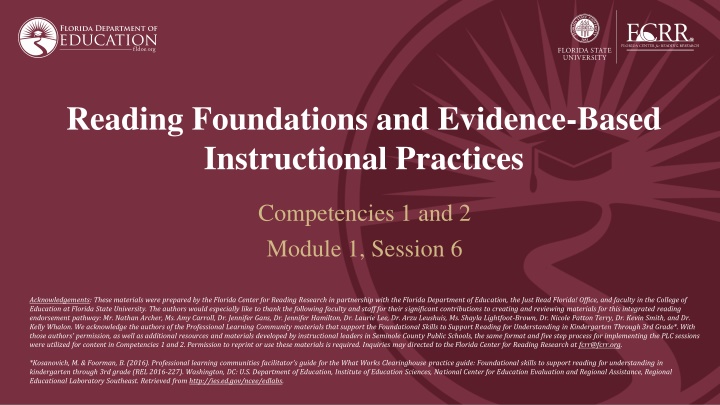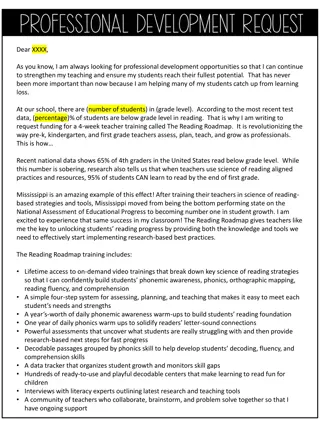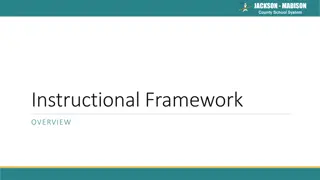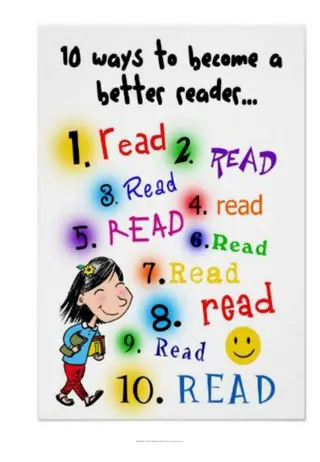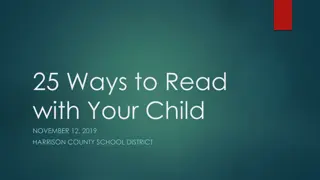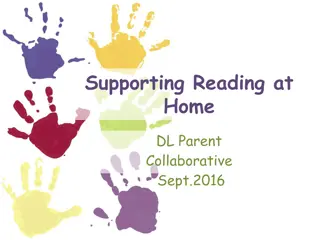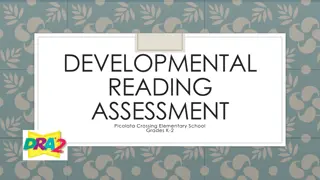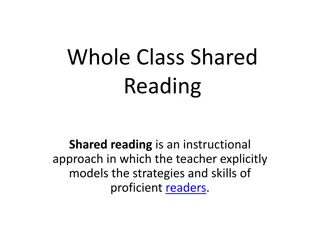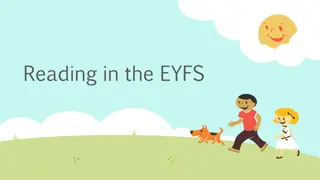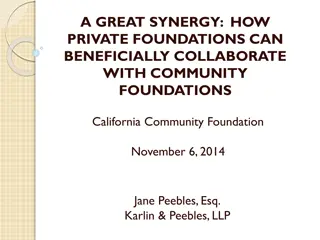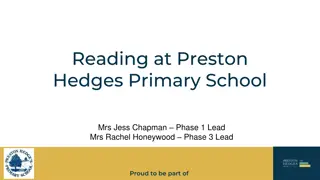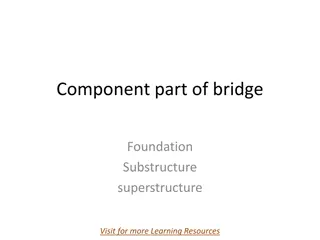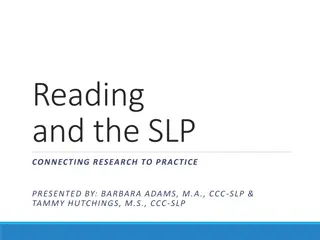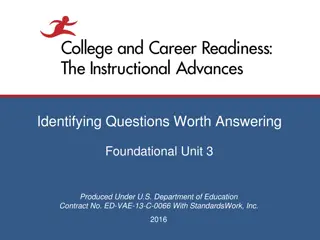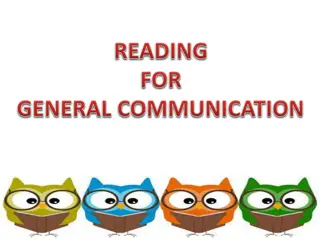Reading Foundations and Evidence-Based Instructional Practices
Culminating project for teachers to apply knowledge in creating lesson series covering various literacy skills. Debrief sessions focus on targeting phonological awareness skills, teaching methods, student responses, and instructional adjustments made.
Download Presentation

Please find below an Image/Link to download the presentation.
The content on the website is provided AS IS for your information and personal use only. It may not be sold, licensed, or shared on other websites without obtaining consent from the author.If you encounter any issues during the download, it is possible that the publisher has removed the file from their server.
You are allowed to download the files provided on this website for personal or commercial use, subject to the condition that they are used lawfully. All files are the property of their respective owners.
The content on the website is provided AS IS for your information and personal use only. It may not be sold, licensed, or shared on other websites without obtaining consent from the author.
E N D
Presentation Transcript
Reading Foundations and Evidence-Based Instructional Practices Competencies 1 and 2 Module 1, Session 6 Acknowledgements: These materials were prepared by the Florida Center for Reading Research in partnership with the Florida Department of Education, the Just Read Florida! Office, and faculty in the College of Education at Florida State University. The authors would especially like to thank the following faculty and staff for their significant contributions to creating and reviewing materials for this integrated reading endorsement pathway: Mr. Nathan Archer, Ms. Amy Carroll, Dr. Jennifer Gans, Dr. Jennifer Hamilton, Dr. Laurie Lee, Dr. Arzu Leushuis, Ms. Shayla Lightfoot-Brown, Dr. Nicole Patton Terry, Dr. Kevin Smith, and Dr. Kelly Whalon. We acknowledge the authors of the Professional Learning Community materials that support the Foundational Skills to Support Reading for Understanding in Kindergarten Through 3rd Grade*. With those authors' permission, as well as additional resources and materials developed by instructional leaders in Seminole County Public Schools, the same format and five step process for implementing the PLC sessions were utilized for content in Competencies 1 and 2. Permission to reprint or use these materials is required. Inquiries may directed to the Florida Center for Reading Research at fcrr@fcrr.org. *Kosanovich, M. & Foorman, B. (2016). Professional learning communities facilitator s guide for the What Works Clearinghouse practice guide: Foundational skills to support reading for understanding in kindergarten through 3rd grade (REL 2016-227). Washington, DC: U.S. Department of Education, Institute of Education Sciences, National Center for Education Evaluation and Regional Assistance, Regional Educational Laboratory Southeast. Retrieved from http://ies.ed.gov/ncee/edlabs.
Culminating Project A culminating project will provide evidence that teachers are able to apply the knowledge and skills they developed in this course in their classrooms. Teachers will: develop and deliver a series of five lessons. complete a reflection and submit it. Lesson series will need to include: appropriate grade level standards evidence-based instructional practices and activities that promote comprehension, oral language, phonological awareness, phonics, fluency, and vocabulary whole group and small group lessons differentiated instruction based on data assessments that will inform future instruction A rubric is provided for you to review the culminating projects.
Lets debrief from the last session by reviewing Activity 18! Discuss: 1. Which phonological awareness skill(s) did you target? How did you determine which skill(s) to teach? How many students participated in this lesson? 2. Describe the lesson you taught and the materials you used. 3. Did you teach the lesson as planned? If not, describe any adjustments you made and why you made them. 4. How did your students respond to your instruction? How did you scaffold your instruction? 5. How did you measure student learning?
Lets debrief from the last session by reviewing Activity 23! Discuss: 1. Which phonological awareness skill(s) did you target? How did you determine which skill(s) to teach? How many students participated in the lesson? Describe the lesson you taught and the materials you used. Did you teach the lesson as planned? If not, describe any adjustments you made and why you made them. How did your students respond to your instruction? How did you scaffold your instruction? How did you measure student learning? 2. 3. 4. 5.
RECOMMENDATION THREE Teach students to decode words, analyze word parts, and write and recognize words.
Recommendations 1. Teach students academic language skills, including the use of inferential knowledge and narrative language, and vocabulary knowledge. 2. Develop awareness of the segments of sounds in speech and how they link to letters. 2. Teach students to decode words, analyze word parts, and write and recognize words. 4. reading accuracy, fluency, and comprehension. Ensure that each students read connected text every day to support
Recommendation 3: Blending Common Sound-Spelling Patterns How-to Step 1: Teach students to blend letter sounds and sound spelling patterns from left to right within a word to produce a recognizable pronunciation. How-to Step 2: Instruct students in common sound spelling patterns. How-to Step 3: Teach students to recognize common word parts. How-to Step 4: Have students read decodable words in isolation and in text. How-to Step 5: Teach regular and irregular high-frequency words so that students can recognize them efficiently. How-to Step 6: Introduce non-decodable words that are essential to the meaning of text as whole words.
SESSION 6: BLENDING COMMON SOUND-SPELLING PATTERNS Teach students to decode words, analyze word parts, and write and recognize words. How-to Step 1: Teach students to blend letter-sound and sound-spelling patterns from left to right within a word to produce a recognizable pronunciation. How-to Step 2: Instruct students in common sound-spelling patterns.
Recommendation 3 addresses teaching students to decode words, analyze word parts, and write and recognize words. This session reviews the first and second How-to steps for carrying out Recommendation 3. The goal of this session is to address teaching students to blend letter sounds and sound spelling patterns and instructing students in common sound spelling patterns. These steps are found on pages 22-26 of the practice guide. Discuss your initial thoughts or questions about the recommendation and How-to Steps.
Access Prior Knowledge: 1. The level of evidence for this recommendation is strong. Teaching students to decode and recognize words and word parts was one of the effective instructional techniques identified by the National Reading Panel (NRP). Recent evidence reviewed for this practice guide supports the NRP s conclusions. 2. Work in small groups of two to three. share how you teach blending and common sound spellings. 3. Discuss the challenges that arise when teaching students how to blend and how you teach common sound spellings
Moving Into New Learning: Review with the group Table D.6 on page 77 in Appendix D. These studies describe the eighteen studies supporting Recommendation 3. Discuss the nature of the studies that specifically address How-to Steps 1 and 2: Teach students to blend letter sounds and sound spelling patterns from left to right within a word to produce a recognizable pronunciation and instruct students in common sound spelling patterns. The last column of the table notes the related How-to Steps each study addresses. Look at those studies that include both Steps 1 and 2 (e.g., Gunn et al., 2005) and discuss the intervention condition as implemented in the study located in column 3.
How-to Step 1 addresses teaching students to blend letter sounds and soundspelling patterns from left to right within a word to produce a recognizable pronunciation. Refer to pages 23-25 of the practice guide. Discuss blending: What is the definition of blending? Which type of words should you use when beginning to teach blending? Why? What are two types of blending? Describe each one. What is another way to demonstrate chunking or sounding out? What are important things to address regarding pronunciation when teaching students to blend words?
Video 21: Blending by Chunking; Blending by Sounding Out This video shows two different ways in which to teach blending. The first part of the video shows blending by chunking and the second part shows blending by sounding out. Refresh your memory of Example 3.1 on page 24. After watching, discuss: Discuss the differences between the two instructional techniques. Who uses which technique? Share experiences using each of the techniques.
Blending by chunking with a pocket chart and letter tiles. Refer to the bottom of page 24 of the practice guide. Does anyone use a pocket chart and letter cards to teach blending by chunking? Discuss your experiences with it.
How-to Step 2 addresses teaching students common sound spelling patterns. Refer to page 25 of the practice guide. Discuss: What is important to do when teaching letter combinations or sound spelling patterns? Review Example 3.3 on page 25. Why is it important to understand consonant, vowel, and syllable-construction patterns and teach them to students?
Video 22: Building Words with Sound Boxes Sound boxes are the same as Elkonin boxes. Review the three activities to introduce and practice sound spelling patterns found on page 26. Are there any here that you would like to incorporate into your instruction? Review Example 3.4 on page 26 of the practice guide. After watching, discuss: Where should a silent-e be placed? Why? Where should a consonant digraph (e.g., sh, th, ph) be placed? Why? Where should a vowel team (e.g., oa, ea, igh) be placed? Why? Where should an r-controlled vowel (e.g., ar, er, ir) be placed? Why?
Video 23: Vowel Pattern Word Sort This video illustrates a word sort focused on vowel patterns. In this activity, students are provided word cards with the target pattern. Cards are sorted into groups. After watching, discuss: What do word sorts help students do? How can word sorts be incorporated into your instruction? How could this activity be extended?
Compare Current Practice Discuss the following: In Video 21:Blending by Chunking; Blending by Sounding Out, two instructional techniques were illustrated. How are these techniques similar to or different from the way you currently teach blending? The other two videos illustrated How-to Step 2, which is to instruct students in common sound spelling patterns. The first video used sound boxes and the other video showed a word sort. How are these activities similar to or different from the way you currently teach common sound spelling patterns?
Potential Obstacles for Implementing Recommendation 3 Review and discuss the potential obstacles to implementing Recommendation 3. Read the panel s advice on page 31. Obstacle 3.1- My students often invent spellings for words when I am not able to respond to their questions immediately. Should I discourage this habit? Obstacle 3.2- Students are able to identify the sounds of the letters in a word, but they have trouble arriving at the correct pronunciation for the word. Discuss obstacles you have experienced and ways in which you overcame them.
Activity 1: Blending Work in small groups of two or three and practice teaching blending by chunking with a pocket chart and letter cards (see Example 3.2 on page 24 of the practice guide) and blending by sounding out using a whiteboard and marker (see Example 3.1 on page 24 of the practice guide). Each small group can either select words or use the following words: map, sit, sat, fin. Share your thoughts and experiences using these two techniques to teach blending.
Activity 2: Common Sound-Pattern Spelling Work in groups of two to three and review Activity 24 and Activity 25. Complete a lesson plan on building words with sound boxes. Recently taught sound spelling patterns are provided. Determine the list of words, develop an activity sheet of sound boxes correlated to the list of words, list materials, describe the teaching procedure, and note an extension and evidence of student learning. Share your lesson plan with the whole group.
Reflect: Is there anything you learned during this session that either confirms or contradicts what you already knew about teaching blending or common sound spelling patterns? Brainstorm ideas about what strategies you would add or change to teach students blending or common sound spelling patterns. Discuss ideas for how to implement these additional strategies. What data will you use to determine whether the additions or changes you made resulted in improved student learning?
Implement: Develop and implement a lesson plan on building words using sound boxes. Select recently taught sound spelling patterns in your own classroom and develop a list of words using those sound spelling patterns. Next, develop an activity sheet of sound boxes correlated to the list of words. List the materials, describe the teaching procedure, and note an extension and evidence of student learning. Use Activity 26: Building Words with Sound Boxes Lesson Plan to Implement to develop a lesson and then teach the lesson to students.
Implement: Complete Activity 27: Prepare to Share. At the start of the next PLC session, be prepared to respond to the following: Which sound spelling patterns did you target? How did you determine which skill to teach? Which words did you select? How many students participated in the lesson? Describe the lesson you taught and the materials used. Did you teach the lesson as planned? If not, describe any adjustments you made and why you made them.
Implement: How did your students respond to your instruction? How did you scaffold your instruction? How did you measure student learning?
